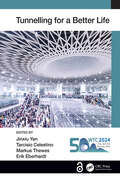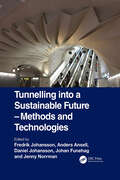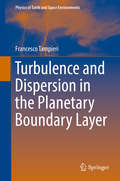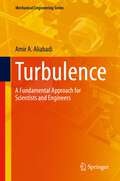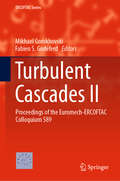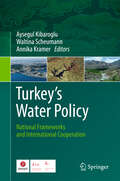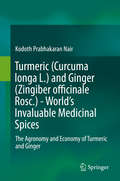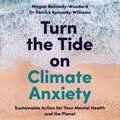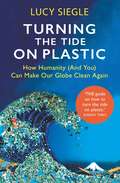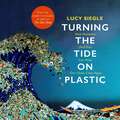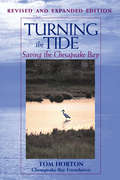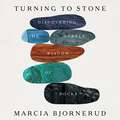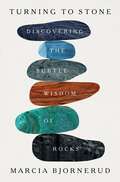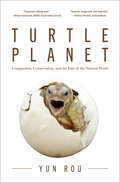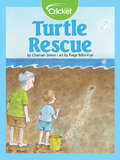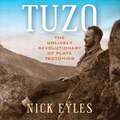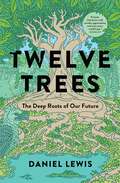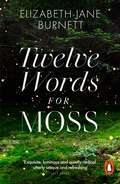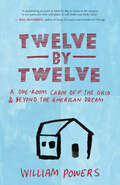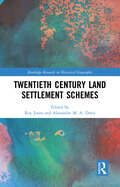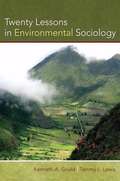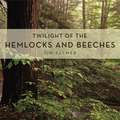- Table View
- List View
Tunnelling for a Better Life
by Jinxiu YanTunnelling for a Better Life contain the contributions presented at the ITA-AITES World Tunnel Congress 2024, which was held from 19-25 April 2024 in Shenzhen, China. As urbanization accelerates, the pivotal role of tunnels and underground spaces in fostering environmental sustainability and improving quality of life becomes ever more pronounced. These underground structures serve as sustainable solutions to the challenges posed by rapid urban growth. By seamlessly integrating into urban landscapes, they alleviate congestion, reduce pollution, and enhance overall mobility, thus contributing to a greener and more sustainable urban environment. Moreover, tunnels and underground works provide vital support for various urban functions, such as accommodating economic activities, providing safe shelters during emergencies or disasters, and facilitating efficient utility management. They address immediate urban needs and lay the foundation for a better and more resilient future.By focusing on the latest trends in tunnelling and underground engineering, and looking ahead to the era of low-carbon and intelligent technology, the papers in this book illustrate the transformative potential of tunnels and underground works in shaping a better life for present and future generations. The contributions cover a comprehensive range of topics on tunnel engineering, showcasing the latest advancements, insights, and innovations across the following areas:1. Planning and General Aspects2. Design and Methodology3. Geotechnics, Geology and Geophysical Prospecting4. Ground Stability and Consolidation5. Support and Lining6. Conventional Tunnelling7. Mechanized Tunneling (TBM, shield)8. Immersed Tunnels9. Waterproofing and Drainage10. Instrumentation and Monitoring/ Testing and Inspection11. Digital and Information Technology12. Machine Learning13. Underground Caverns/Underground Space Use14. Operational Safety, Maintenance and Repair15. Contractual Practices and Risk ManagementTunnelling for a Better Life is a must-read for professionals, engineers, owners, and other stakeholders worldwide in tunnelling and underground engineering.
Tunnelling into a Sustainable Future – Methods and Technologies: Proceedings of the ITA-AITES World Tunnel Congress 2025 (WTC 2025), 9-15 May 2025, Stockholm, Sweden
by Fredrik JohanssonTunnelling into a Sustainable Future – Methods and Technologies contains the contributions presented at the ITA-AITES World Tunnel Congress 2025 (Stockholm, Sweden, 9-15 May 2025). The contributions cover a wide range of topics in the fields of tunnelling and underground engineering, including:1. Innovating tunneling2. Safety Underground3. Use of underground space4. Investigations and ground characterisation5. Planning and design of underground space6. Conventional tunnelling7. Mechanised tunnelling8. Complex geometries including shafts and ramps9. Grouting and groundwater control10. Instrumentation and monitoring11. Operation, inspection and maintenance12. Contractual aspects, financing and risk management13. Impact from climate changeTunnelling into a Sustainable Future – Methods and Technologies will serve as a valuable reference to all concerned with tunnelling and underground engineering, including students, researchers and engineers.
Turbulence and Dispersion in the Planetary Boundary Layer
by Francesco TampieriThis book offers a comprehensive review of our current understanding of the planetary boundary layer, particularly the turbulent exchanges of momentum, heat and passive scalars between the surface of the Earth and the atmosphere. It presents and discusses the observations and the theory of the turbulent boundary layer, both for homogeneous and more realistic heterogeneous surface conditions, as well as the dispersion of tracers. Lastly it addresses the main problems arising due to turbulence in weather, climate and atmospheric composition numerical models. Written for postgraduate and advanced undergraduate-level students and atmospheric researchers, it is also of interest to anyone wanting to understand the findings and obtain an update on problems that have yet to be solved.
Turbulence: A Fundamental Approach for Scientists and Engineers (Mechanical Engineering Series)
by Amir A. AliabadiThis textbook explains turbulent flows using an introductory but fundamental approach to teaching the core principles, striking a balance between theoretical and practical aspects of the topic without overwhelming the reader with mathematical detail. It is aimed at students in various engineering disciplines—mechanical, civil, environmental—and the geosciences. It is divided in five parts. Part 1 provides the fundamentals of turbulence, main hypotheses, and analysis tools; Part 2 illustrates various measurement techniques used to study turbulent flows; Part 3 explains the modelling and simulation frameworks to study turbulent flows; Part 4 describes brief applications of turbulence in engineering and sciences; and Part 5 presents basic statistical, mathematical, and numerical tools. Elucidates the theory behind turbulence in a concise yet rigorous manner Combines theoretical, computational, experimental, and applied aspects of the topic Reinforces concepts with practice problems at the end of each chapter Provides brief chapters on statistics, mathematics, and numerical techniques
Turbulent Cascades II: Proceedings of the Euromech-ERCOFTAC Colloquium 589 (ERCOFTAC Series #26)
by Mikhael Gorokhovski Fabien S. GodeferdGathering contributions by the most prominent researchers in a highly specialised field, this proceedings volume clarifies selected aspects of the physics of turbulent cascades and their statistical universalities under complex stationary and non-homogeneous conditions. Here, these conditions are induced by the presence of a gas/liquid interface, inertial particles, strong shear, rotation, MHD and stratification. By proposing different ways to model turbulence effects under these complex conditions, the book will be of considerable interest not only to academic researchers, but also to specialists and junior researchers in the domain of propulsion and power, as well as those whose work involves various applications related to atmospheric, oceanic and planetary physics.
Turkey's Water Policy: National Frameworks and International Cooperation
by Annika Kramer Waltina Scheumann Aysegul KibarogluWater is a strategic natural resource of vital importance to all nations. As such it has been the cause of several international disputes. For Turkey especially, water is crucial to social and economic development. Turkey's current national water regime that emphasises water resources development and management for productive uses, however, faces growing environmental concerns and international criticism regarding transboundary water cooperation. Furthermore, EU accession requires Turkey to adopt an extensive and ambitious body of EU water law. To understand Turkey's position to international water law, the national policies and socio-economic circumstances that impact water resources management need to be considered. This book fills the existing knowledge gap through a broad perspective and analysis of the current state of Turkey's water policy and its management of both national and transboundary waters. It is a unique undertaking that brings together Turkish and international authors, practitioners and academics, covering all aspects of water management
Turmeric (Curcuma longa L.) and Ginger (Zingiber officinale Rosc.) - World's Invaluable Medicinal Spices: The Agronomy and Economy of Turmeric and Ginger
by Kodoth Prabhakaran NairThis book discusses the various aspects, from production to marketing of turmeric and ginger, the world’s two most important and invaluable medicinal spice crops. The book begins with their origin and history, global spread, and goes on to describe the botany, production agronomy, fertilizer practices, pest management, post-harvest technology, pharmacology and nutraceutical uses. The book presents the economy, import-export and world markets involved with reference to turmeric and ginger. It would be a benchmark and an important reference source for scientists, students, both undergraduate and post graduate, studying agriculture and food sciences and policy makers. It would be of great interest to professionals and industry involved in spice trade.
Turn the Tide on Climate Anxiety: Sustainable Action for Your Mental Health and the Planet
by Megan Kennedy-Woodard Dr. Patrick Kennedy-WilliamsIt's hard to watch the news, scroll through social media, or listen to the radio without hearing or seeing something disturbing about the climate emergency. This can trigger all sorts of emotions: worry, anger, sadness, guilt, and even grief but also often over-looked positive emotions like motivation, connection, care, and abundance that support mental health and climate action for sustainable longevity.Written by psychologists with extensive experience in treating people with eco-anxiety, this book shows you how to harness these emotions, validate them, and transform them into positive action. It enables you to assess and understand your psychological responses to the climate crisis and move away from unhealthy defence mechanisms, such as denial and avoidance.Ultimately, it shows that the solution to both climate anxiety and the climate crisis is the same - action that is sustainable for you and for the planet - and empowers you to take steps towards this.
Turn the Tide on Climate Anxiety: Sustainable Action for Your Mental Health and the Planet
by Megan Kennedy-Woodard Dr. Patrick Kennedy-WilliamsHow to understand and manage your psychological responses to climate change to protect your mental health (and the planet).It's hard to watch the news, scroll through social media, or listen to the radio without hearing or seeing something disturbing about the climate emergency. This can trigger all sorts of emotions: worry, anger, sadness, guilt, and even grief but also often over-looked positive emotions like motivation, connection, care, and abundance that support mental health and climate action for sustainable longevity.Written by psychologists with extensive experience in treating people with eco-anxiety, this audiobook shows you how to harness these emotions, validate them, and transform them into positive action. It enables you to assess and understand your psychological responses to the climate crisis and move away from unhealthy defence mechanisms, such as denial and avoidance.Ultimately, it shows that the solution to both climate anxiety and the climate crisis is the same - action that is sustainable for you and for the planet - and empowers you to take steps towards this.(P) 2022 Jessica Kingsley Publishers
Turning Center Programming, Setup, and Operation Textbook: A Guide To Mastering The Use Of CNC Turning Centers
by Mike LynchIt is the intention of this text to introduce beginners and experienced CNC people alike to programming, setup, and operation techniques used to utilize CNC turning centers. We will begin in a basic manner, ensuring that even newcomers to CNC will be able to follow the presentations. And we use a building blocks approach -- so as you get deeper into the material -- we'll be adding to what you already know. When you're finished, you will have a thorough understanding of what it takes to program, setup, and run a CNC turning center. We use a Key Concepts approach to presenting CNC. The Key Concepts allow us to minimize the number of major topics you must master in order to become proficient with CNC turning center usage.
Turning the Tide on Plastic: How Humanity (And You) Can Make Our Globe Clean Again
by Lucy SiegleEnough plastic is thrown away every year to circle the world 4 times More than 8 million tonnes of plastic enter the oceans each year 300 million tonnes of new plastic is produced every year An estimated 15-51 trillion pieces of plastic now litter the world's oceans 38.5 million plastic bottles are used every day in the UK A million plastic bottles are used per minute around the world 500 million plastic straws are used per year Without big action, at the current rate, pieces of plastic will outnumber fish in the ocean by 2050. That is the legacy we are leaving our children and grandchildren. Plastic flows into our lives from every direction and most of it is not recycled. Instead it is incinerated or ends up in landfill, where it will sit for hundreds of years, or enters the world's seas where it fragments into tiny pieces to become microplastics - the environmental scourge of our times. Many of us had assumed that governments, brands and waste authorities were dealing with plastic on our behalf. But the impact of shows such as Blue Planet along with national beach cleans and high-profile campaigns have resulted in a collective wake-up call. If there were plans and strategies, they have not worked as we imagined. It would be easy to feel despondent but instead we need to turn our anger and emotion into action, starting by making a big dent in our own enormous consumption. Turning the tide on Plastic is here just in time. Journalist, broadcaster and eco lifestyle expert Lucy Siegle provides a powerful call to arms to end the plastic pandemic along with the tools we need to make decisive change. It is a clear-eyed, authoritative and accessible guide to help us to take decisive and effective personal action. Because this matters. When it comes to single-use plastics, we are habitual users, reaching out for plastic water bottles, disposable coffee cups, plastic straws and carrier bags multiple times a day. If only 12 of us adopt Lucy's 'reduce, rethink, refill, refuse' approach, we could potentially ditch 3K-15K single items of plastic in a year. When we consider our power as influencers - whether at school, the hairdressers, at work or on the bus - we suddenly become part of something significant. So now is the time to speak up, take action and demand the change you want to see in the ocean, in the supermarket aisles and on the streets. It's time to turn the tide on plastic, and this book will show you how.
Turning the Tide on Plastic: How Humanity (And You) Can Make Our Globe Clean Again
by Lucy SiegleEnough plastic is thrown away every year to circle the world 4 timesMore than 8 million tonnes of plastic enter the oceans each year300 million tonnes of new plastic is produced every year An estimated 15-51 trillion pieces of plastic now litter the world's oceans 38.5 million plastic bottles are used every day in the UKA million plastic bottles are used per minute around the world500 million plastic straws are used per yearPlastic flows into our lives from every direction and most of it is not recycled. Instead it is incinerated or ends up in landfill, where it will sit for hundreds of years, or enters the world's seas where it fragments into tiny pieces to become microplastics - the environmental scourge of our times. Without big action, at the current rate, pieces of plastic will outnumber fish in the ocean by 2050. That is the legacy we are leaving our children and grandchildren.Turning the tide on Plastic is here just in time. Journalist, broadcaster and eco lifestyle expert Lucy Siegle provides a powerful call to arms to end the plastic pandemic along with the tools we need to make decisive change. It is a clear-eyed, authoritative and accessible guide to help us to take decisive and effective personal action. If only 12 of us adopt Lucy's 'reduce, rethink, refill, refuse' approach, we could potentially ditch 3K-15K single items of plastic in a year. When we consider our power as influencers - whether at school, the hairdressers, at work or on the bus - we suddenly become part of something significant. So now is the time to speak up, take action and demand the change you want to see in the ocean, in the supermarket aisles and on the streets. It's time to turn the tide on plastic, and this book will show you how.This audio edition features exclusive extra material, including:An interview with Hugo Tagholm, CEO of Surfers Against SewageAn interview with Emily Penn, Mission Director and co-founder of eXXpedition, recorded live from Hawaii ahead of eXXpedition's voyage through the Great Pacific Garbage Patch, the densest ocean plastic accumulation zone on the planet.Tips from Fiona Llewelyn, Chair of Plastic Free St.Agnes, for how your community can cut down plastic use.Written and Read by Lucy Siegle(p) Orion Publishing Group Ltd 2018
Turning the Tide: Saving the Chesapeake Bay
by Tom Horton Chesapeake Bay Foundation William Chesapeake Bay FoundationIn 1991, Island Press published Turning the Tide, a unique and accessible examination of the Chesapeake Bay ecosystem. The book took an indepth look at the Bay's vital signs to gauge the overall health of its entire ecosystem and to assess what had been done and what remained to be done to clean up the Bay. This new edition of Turning the Tide addresses new developments of the past decade and examines the factors that will have the most significant effects on the health of the Bay in the coming years.With new case studies and updated maps, charts, and graphs, the book builds on the analytical power of ten years of experience to offer a new perspective, along with clear, science-based recommendations for the future. For all those who want to know not only how much must be done to save the Bay but what they can do and how they can make a difference, Turning the Tide is an essential source of information.
Turning to Stone
by Marcia Bjornerud'A nuanced celebration of the language of stone' DAVID GEORGE HASKELL'A unique and timeless book' ROBERT HALZENRocks are the record of our creative planet reinventing itself for four billion years. Nothing is ever lost, just transformed. Marcia Bjornerud's life as a geologist has coincided with an extraordinary period of discovery. From an insular girlhood in rural Wisconsin, she found her way to an unlikely career studying mountains in remote parts of the world. As one of few women in her field, she witnessed the shift in our understanding of the Earth, from solid object to an entity in a constant state of transformation. In the most tumultuous times of her own life, a deep understanding of our rocky planet imbued her life with meaning.The lives of rocks are long and complex, spanning billions of years and yet shaping our own human lives in powerful, invisible ways. Sandstone that filters out pathogens creating underground oases in aquifers of clean water. Ecologite is "the chosen rock" whose formation keeps the planet running. Earth is not just a passive backdrop, or a source of resources to be mined, extracted, and carved out. Rocks are full of wisdom, but somewhere along the way many of us have forgotten how to hear it.When we are uncertain about where to find truth, a geocentric worldview reminds us that we are Earthlings, part of a planetary community where we can find wisdom in the most unlikely places.
Turning to Stone
by Marcia Bjornerud'A nuanced celebration of the language of stone' DAVID GEORGE HASKELL'A unique and timeless book' ROBERT HALZENRocks are the record of our creative planet reinventing itself for four billion years. Nothing is ever lost, just transformed. Marcia Bjornerud's life as a geologist has coincided with an extraordinary period of discovery. From an insular girlhood in rural Wisconsin, she found her way to an unlikely career studying mountains in remote parts of the world. As one of few women in her field, she witnessed the shift in our understanding of the Earth, from solid object to an entity in a constant state of transformation. In the most tumultuous times of her own life, a deep understanding of our rocky planet imbued her life with meaning.The lives of rocks are long and complex, spanning billions of years and yet shaping our own human lives in powerful, invisible ways. Sandstone that filters out pathogens creating underground oases in aquifers of clean water. Ecologite is "the chosen rock" whose formation keeps the planet running. Earth is not just a passive backdrop, or a source of resources to be mined, extracted, and carved out. Rocks are full of wisdom, but somewhere along the way many of us have forgotten how to hear it.When we are uncertain about where to find truth, a geocentric worldview reminds us that we are Earthlings, part of a planetary community where we can find wisdom in the most unlikely places.
Turning to Stone: Discovering the Subtle Wisdom of Rocks
by Marcia BjornerudEarth is vibrantly alive and full of wisdom for those who learn to listen.Earth has been reinventing itself for more than four billion years, keeping a record of its experiments in the form of rocks. Yet most of us live our lives on the planet with no idea of its extraordinary history, unable to interpret the language of the rocks that surround us. Geologist Marcia Bjornerud believes that our lives can be enriched by understanding our heritage on this old and creative planet. Contrary to their reputation, rocks have eventful lives–and they intersect with our own in surprising ways. In Turning to Stone, Bjornerud reveals how rocks are the hidden infrastructure that keep the planet functioning, from sandstone aquifers purifying the water we drink to basalt formations slowly regulating global climate. Bjornerud’s life as a geologist has coincided with an extraordinary period of discovery in the geosciences. From an insular girlhood in rural Wisconsin, she found her way to an unlikely career studying mountains in remote parts of the world and witnessed the emergence of a new understanding of the Earth as an animate system of rock, air, water and life. We are all, most fundamentally, Earthlings and we can find existential meaning and enduring wisdom in stone.
Turtle Planet: Compassion, Conservation, and the Fate of the Natural World
by Yun Rou#1 New Release in Biology of Reptiles & Amphibians and in Taoism - Explore the Bond Between Humans and AnimalsBe a part of it-2020 is Designated “Year of the Turtle” by Zoological and Conservation Organizations.Turtle Planet is a work of philosophical fact and fiction by ordained Daoist Monk Yun Rou. This beautifully written work of thought deeply explores the bond between humans and animals?the wisdom they teach us, the wounds they can heal, and the role we play in their destruction.A Daoist focus on personal cultivation, environmental conservation, and political and social justice. Daoist Monk Yun Rou received his academic education at Yale, Cornell, and the University of California and was ordained a Daoist monk at the Chun Yang (Pure Yang) Taoist Temple in Guangzhou, China. Drawing on fifty years of loving and husbanding turtles, from the car-sized giant Leatherback turtle to the Central Asian tortoise, Monk Yun Rou sounds the alarm of what climate change, global extinction, human intervention, and environmental devastation really mean to their worlds and to ours.See the world through the eyes of turtles. Turtle Planet renders the wonders and suffering of the natural world through the eyes of eighteen exotic turtles. An informational glossary and description of each turtle at the end of the book is provided as a bonus gift to readers.If you have read and learned from books such as H is for Hawk, The Soul of an Octopus, or Ishmael; you will be moved by Turtle Planet, a must for any reader who loves nature, cherishes animals, and celebrates ideas.
Turtle Rescue
by Charnan SimonNana is a turtle trekker! She can help Stella take care of the baby sea turtle they find on the beach.
Tuzo: The Unlikely Revolutionary of Plate Tectonics
by Nick EylesTuzo is the never-before-told story of one of Canada’s most influential scientists and the discovery of plate tectonics, a pivotal development that forever altered how we think of our planet. In 1961, a Canadian geologist named John "Jock" Tuzo Wilson (1908–1993) jettisoned decades of strongly held opposition to theories of moving continents and embraced the idea that they drift across the surface of the Earth. Tuzo tells the fascinating life story of Tuzo Wilson, from his early forays as a teenaged geological assistant working on the remote Canadian Shield in the 1920s to his experiences as a civilian-soldier in the Second World War to his ultimate role as the venerated father of plate tectonics. Illuminating how science is done, this book blends Tuzo’s life story with the development of the theory of plate tectonics, showing along the way how scientific theories are debated, rejected, and accepted. Gorgeously illustrated, Tuzo will appeal to anyone interested in the natural world around them.
Twelve Trees: The Deep Roots of Our Future
by Daniel LewisA compelling global exploration of nature and survival as seen via a dozen species of trees, offering &“extensive insight into the ways in which humans and trees are interconnected&” (BookPage), revealing the challenges facing our planet and how scientists are working urgently to save our forests and our future.The world today is undergoing the most rapid environmental transformation in human history—from climate change to deforestation. Scientists, ethnobotanists, indigenous peoples, and collectives of all kinds are closely studying trees and their biology to understand how and why trees function individually and collectively in the ways they do. In Twelve Trees, Daniel Lewis, curator and historian at one of the world&’s most renowned research libraries, travels the world to learn about these trees in their habitats. Lewis takes us on a sweeping journey to plant breeding labs, botanical gardens, research facilities, deep inside museum collections, to the tops of tall trees, underwater, and around the Earth, journeying into the deserts of the American west and the deep jungles of Peru, to offer a globe-spanning perspective on the crucial impact trees have on our entire planet. When a once-common tree goes extinct in the wild but survives in a botanical garden, what happens next? How can scientists reconstruct lost genomes and habitats? How does a tree store thousands of gallons of water, or offer up perfectly preserved insects from millions of years ago, or root itself in muddy swamps and remain standing? How does a 5,000-year-old tree manage to live, and what can we learn from it? And how can science account for the survival of one species at the expense of others? Twelve Trees &“brims with wonder, appreciation, and even some small hope&” (Booklist) and is an awe-inspiring story of our world, its past, and its future. Note—species include: * The Lost Tree of Easter Island (Sophora toromiro) * The coast redwood (Sequoia sempervirens) * Hymenaea protera [a fossil tree] * The Longleaf pine (Pinus palustris) * East Indian sandalwood (Santanum album) * The Bristlecone pine (Pinus longaeva) * West African ebony (Diospyros crassiflora) * The Tasmanian blue gum eucalyptus (Eucalyptus globulus) * Olive tree (Olea europaea) * Baobab (Adansonia digitata) * the kapok tree (Ceiba pentandra) * The bald cypress (Taxodium distichum)
Twelve Words for Moss: Love, Loss And Moss
by Elizabeth-Jane BurnettSHORTLISTED FOR THE JHALAK PRIZE 2024Shortlisted for the Wainwright Prize 2023 for Nature Writing'Exquisite, luminous and quietly radical . . . utterly unique and refreshing' Lucy JonesWhere nothing grows, moss is the spark that triggers new life. Embarking on a journey though landscape, memory and recovery, Elizabeth-Jane Burnett explores this mysterious, ancient marvel of the plant world, meditating on and renaming her favourite mosses – from Glowflake to Little Loss – and drawing inspiration from place, people and language itself. 'Fascinating, subtle and risk-taking . . . Poetry, descriptive-evocative prose, memory, memoir, natural history and more all drift and mingle in strikingly new ways' Robert Macfarlane
Twelve by Twelve: A One-Room Cabin Off the Grid and Beyond the American Dream
by Bill PowersWhy would a successful American physician choose to live in a twelve-foot-by-twelve-foot cabin without running water or electricity? To find out, writer and activist William Powers visited Dr. Jackie Benton in rural North Carolina. No Name Creek gurgled through Benton’s permaculture farm, and she stroked honeybees’ wings as she shared her wildcrafter philosophy of living on a planet in crisis. Powers, just back from a decade of international aid work, then accepted Benton’s offer to stay at the cabin for a season while she traveled. There, he befriended her eclectic neighbors — organic farmers, biofuel brewers, eco-developers — and discovered a sustainable but imperiled way of life. In these pages, Powers not only explores this small patch of community but draws on his international experiences with other pockets of resistance. This engrossing tale of Powers’s struggle for a meaningful life with a smaller footprint proposes a paradigm shift to an elusive “Soft World” with clues to personal happiness and global healing.
Twentieth Century Land Settlement Schemes (Routledge Research in Historical Geography)
by Roy Jones Alexandre M.A. DinizLand settlement schemes, sponsored by national governments and businesses, such as the Ford Corporation and the Hudson’s Bay Company, took place in locations as diverse as the Canadian Prairies, the Dutch polders, and the Amazonian rainforests. This novel contribution evaluates a diverse range of these initiatives. By 1900, any land that remained available for agricultural settlement was often far from the settlers’ homes and located in challenging physical environments. Over the course of the twentieth century, governments, corporations and frequently desperate individuals sought out new places to settle across the globe from Alberta to Papua New Guinea. This book offers vivid reports of the difficulties faced by many of these settlers, including the experiences of East European Jewish refugees, New Zealand soldier settlers and urban families from Yorkshire. This book considers how and why these settlement schemes succeeded, found other pathways to sustainability or succumbed to failure and even oblivion. In doing so, the book indicates pathways for the achievement of more economically, socially and environmentally sustainable forms of human settlement in marginal areas. This engaging collection will be of interest to individuals in the fields of historical geography, environmental history and development studies.
Twenty Lessons in Environmental Sociology
by Tammy L. Lewis Kenneth A. GouldThe most student-oriented book available for environmental sociology courses, Twenty Lessons in Environmental Sociology introduces undergraduates to the subject in a groundbreaking new way. Instead of compiling articles from professional journals, this innovative reader presents twenty classroom-tested "lessons" from dedicated, experienced teachers. These diverse readings examine key topics in the field, from the social construction of nature to the growing influence of global media on our understanding of the environment. Building this collection on the model of a successful undergraduate classroom experience, coeditors Kenneth A. Gould and Tammy L. Lewis asked the contributors to choose a topic, match it with their favorite class lecture, and construct a lesson to reflect the way they teach it in the classroom. The result is an engaging, innovative, and versatile volume that presents the core ideas of environmental sociology in concise, accessible chapters. Each brief lesson is designed as a stand-alone piece and can be easily adapted into an existing course syllabus. Ideal for any course that looks at the environment from a sociological perspective, Twenty Lessons in Environmental Sociology offers an insightful introduction to this dynamic subject.
Twilight of the Hemlocks and Beeches (Keystone Books)
by Tim PalmerIn this magnificently illustrated book, conservationist and celebrated outdoors photographer Tim Palmer launches us on a revealing journey among the hemlock and beech trees that have for millennia towered over America’s eastern woodlands. The eastern hemlock and North American beech once thrived from Maine to Georgia, casting shade on trout streams, nourishing wildlife large and small, and gracing uncounted valleys, mountainsides, parks, and backyards. These trees now face tragic decimation by exotic insects and pathogens. Palmer’s photos record the splendor of the cherished hemlock and beech in the same way that pictures of iconic, historic buildings commemorate classic landmarks gone the way of the wrecking ball. And yet, as Palmer underscores in his final chapter, the lessons learned as we address the fate of these trees can help us chart a better course for all wooded landscapes in the years ahead. This story of loss, scientific inquiry, and prospective recovery is vital to understanding nature in our time.As an act of artistic preservation, a report on the science vital to the survival of these trees, and a call to action, Twilight of the Hemlocks and Beeches assures a lasting legacy for this irreplaceable forest community. With more than one hundred exquisite full-color photographs, this book is a must-have for outdoor enthusiasts, natural historians, ecologists, and all lovers of nature.
